Please Take Note: This is a review of the final game, but it might change slightly based on the success of the Kickstarter campaign. The game is being reviewed on the components and the rules provided with the understanding that “what you see is not what you might get” when the game is published. If you like what you read and want to learn more, we encourage you to visit the game publisher’s website or visit the Kickstarter campaign. Now that we have all that disclaimer junk out of the way, on with the review.
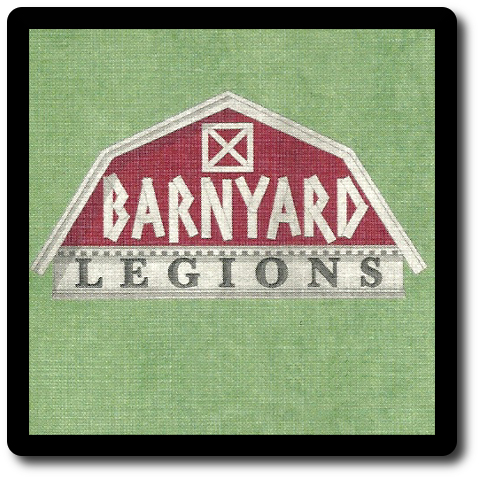
The Basics:
- For ages 8 and up (publisher suggests 13+)
- For 2 to 4 players
- Approximately 30 minutes to complete
Geek Skills:
- Counting & Math
- Logical & Critical Decision Making
- Reading
- Pattern/Color Matching
- Strategy & Tactics
- Visuospatial Skills
- Hand/Resource Management
- Worker Placement & Area Control
Learning Curve:
- Child – Easy
- Adult – Easy
Theme & Narrative:
- Lead your troops to dominate the barnyard!
Endorsements:
- Gamer Geek mixed!
- Parent Geek approved!
- Child Geek mixed!
Overview
Publius Cornelius Tacitus said, “Deos fortioribus adesse.” Which means, in English, “The gods are on the side of the stronger.” In this game, victory will most assuredly go to the stronger army, but strategy and tactics are the true weapons of war. Lead your army across the battleground to claim the Barnyard! Defeat is not an option.
Barnyard Legions, designed by Andrew Meredith and to be published by Games Afoot, will reportedly be comprised of 35 Republic of Ram Legion cards (Roman Sheep), 35 Porklite Phalanx Legion cards (Greek Pigs), 35 Celtucky Chicken Legion cards (Celtic Chickens), 35 Boviking Legion cards (Viking Cows), 20 Mercenary Legion cards (Neutrals for Hire), and 12 Barnyard Cards. As this is a review of a prepublished game, I will not comment on the game component quality.
Preparing the Farm Field for Battle
To set up the game, first take the 12 Barnyard cards and place them face-up so they match the following image. The Barnyard cards are the rectangles noted in red and green. The white spaces are reserved for future cards. The final result will be a 6×6 grid area which defines the “Barnyard” battleground. The Barnyard cards remain where they are placed for the duration of the game and are never removed or moved for any reason.

Second, have each player select and take all the cards for 1 Legion. There are 4 Legions to choose from. No one Legion is more powerful than another, but nor are they identical. One of the Legion cards is a “Banner” Legion card that displays the Legion’s symbol. Find this card and place it face-up in front of the players to help them remember which Legion belongs to which player. Any Legion cards not used are placed back in the game box.
Third, each player shuffles their Legion cards and draws the top 15 cards, placing them face-down in front of them. These are collected and shuffled with the Mercenary cards. This deck is placed above the Barnyard area and is referred to as the Common draw deck. Leave room for a discard pile. The remaining Legion cards still held by the player are placed face-down next to their “Banner” Legion card. This is the player’s Legion draw deck. Leave room for a discard pile that will only contain the player’s Legion cards.
Fourth, draw the top 12 cards from the Common deck and place them on the center (red and green) Barnyard cards, face-up. This seeds the Barnyard and might or might not give one or more players a few Legion cards to use right from the start. I should note that the rules were a bit unclear during our playing sessions when it came to this step. Depending on how you interpret the rules, there was either a typo on the number of cards used or a typo on where the cards were placed. Our groups collectively agreed that drawing 12 cards from the Common deck was the most logical way to set up the game. Either way, I don’t think it makes much of a difference.
Fifth, each player draw 5 Legion cards and 3 Common cards to create their initial hand.
That’s it for game set up. Determine who the first player will be and begin.
Know Your Army
Barnyard Legions is a tactical game of moving armies around the Barnyard. Each of the cards used represents either a specific fighting force or special orders the player gives. Each card type is summarized here.
Players should read each of their cards carefully, including those that belong to their opponents. Barnyard Legions makes heavy use of card text to define what a card can and cannot do, including keywords that are referenced by other cards. There are many unique and condition specific abilities that the players will need to read and understand if they hope to win. While not complicated, it can be a lot to manage at first. My suggestion to new players is to keep scanning the table. Memorization is not necessary, but familiarization is a must.
Legion Unit Cards
The core of the player’s army are the “Unit” Legion cards. Trained and ready for battle, these troops are the bulk of the fighting force and will be the most common card in play. They will also most likely be the cards that will win the game.
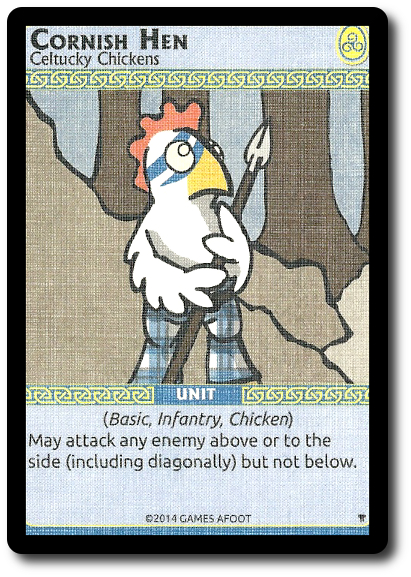
Legion Hero Cards
There are those who rise above their fellow soldiers to become heroes. “Hero” Legion cards are less common, but more powerful than the “Unit” Legion cards, providing unique abilities to keep the battle in the player’s favor. These are “Aces”, so to speak, but not powerful enough to win the war.

Legion Tactics Cards
To win in combat, one must use their mind as well as their sword. “Tactics” Legion cards allow the player to make use of special abilities that are immediately resolved and can shift the game in the player’s favor. Some “Tactics” Legion cards are used once, while others might remain longer in the game.
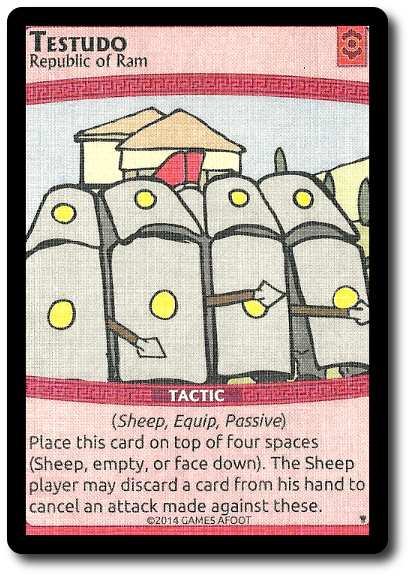
Mercenary Cards
The Mercenary cards consist of neutral “Unit”, “Hero”, and “Tactics” cards. None of which are Legion-specific and can be used by any player. In all case, the Mercenary cards are played just like the player’s Legion cards. The only unique card type is the “Action” Mercenary card. This card type is played like a “Tactics” in almost all cases.
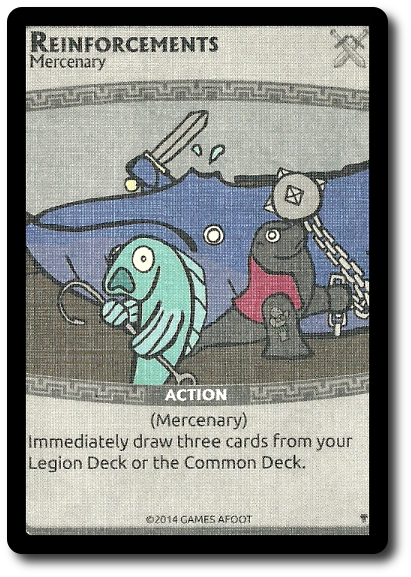
Let Slip the Cows, Pigs, Chickens, Sheep (and Other Various Animals) of War!
Barnyard Legions is played in rounds and turns with no set number of rounds or turns per game. A player’s turn is comprised of 2 steps and multiple actions which are summarized here.
Step 1: Draw One Legion Card (Start of Round Only)
At the top of each round, all players draw 1 Legion card. This is done as a group after the last player in the previous round completest their turn. During this step, a player can be eliminated from the game if they draw their last card from their Legion draw deck.
If this is the first round of game play, this step is skipped.
Step 2: Take 2 or 3 Actions
On a player’s turn, they will take 2 to 3 actions, with the 3rd action being optional. Each action can be taken multiple times and are summarized here. When taking an action with a card (be it already in play or in the player’s hand), only those cards that belong to the player’s Legion or are Mercenaries can be used with a few exception.
Turn Face-Down Cards Face-Up
If a card is in play face-down, it can be flipped over and placed in the same spot face-up if it’s a Unit. If the card is a Tactics, it’s taken into the player’s hand, regardless of what Legion it belongs to.
Draw One Legion Card
The player draws the top card from their Legion draw deck and adds it to their hand. This is the only guaranteed way a player can gather Legion cards they can use, but at a cost. The more cards taken from the player’s Legion draw deck, the closer they get to being knocked out of the game.
Draw Two Common Cards
The player can draw the top 2 cards from the Common draw deck and add them to their hand. Whatever cards are drawn, be they specific to the player’s Legion, an opponent’s Legion, or a Mercenary, they are kept.
Unlike the Legion draw deck, removing the last card from the Common draw deck does not eliminate the player from the game. However, the Common draw deck, once exhausted, will remain unavailable for the duration of the game.
Play One Unit or Hero Card to the Barnyard
The player can select any Unit or Hero card that belongs to their Legion or are Mercenaries and place it to the Barnyard area. The card is placed face-up in any empty space within the 6×6 Barnyard grid area or any empty Barnyard card that is adjacent to (not diagonal) to another card in play. Put another way, the player cannot place a card out in the middle of nowhere. It must be within the grid area and next to another card. The adjacent card need not belong to the player’s Legion and can be face-up or face-down.
Play One Tactics Card
Like Unit and Hero cards, the player can only play Tactics cards that belong to their Legion or are Mercenaries. Tactic cards are taken from the player’s hand, announced, and then read out loud. Once resolved, they normally go to the discard pile next to the Common or Legion draw deck. However, a few “Tactics” Legion cards are played to the Barnyard area. Place the Tactics card so the card beneath is visible to all the players. When placed, the Tactics card is not consider “active”. It must be activated through other cards and actions.
Move One Legion Unit or Hero Card
The player’s “Unit” or “Hero” Legion card can be moved 1 space horizontally or 1 space vertically in the Barnyard area. Some cards allow for additional and different types of movement for only 1 action. Regardless of how far the card can move, it must stay within 6×6 Barnyard grid area and end its movement so it’s adjacent to another card. Barnyard cards do not move, but any Tactics cards on a “Unit” or “Hero” Legion card move with the card to its new destination.
Activate Special Ability
The player can activate a played “Unit” or “Hero” Legion card they own in the Barnyard area. This includes any “Unit” or “Hero” Legion cards just played. The only limitation is that each “Unit” and “Hero” Legion card can only activate their special ability once per turn.
Basic Attack
All “Unit” and “Hero” Legion cards, as well as Mercenary cards, that have a basic attack action can take one. Any cards adjacent to the card is a potential target. The player announces the basic attack, points to the card they are attacking, and waits for the card’s owner (if it’s a Legion card) to attempt to save it. If the opponent cannot or if the card is a Mercenary card, it’s discarded. Any Tactics card on the removed card are also discarded. The space is now open to move into or play cards to. As always, Barnyard cards remain.
Optional Third Action
After the player has taken their 2 actions, they can discard any card from their hand to get 1 additional action. The card discarded can be of any type and from any Legion.
This completes the player’s turn. After taking 2 or 3 actions, the next player in turn order sequence now goes.
Continuing the Battle and Ending the War
As soon as a player is able to create a row, column, or diagonal line of 5 or 6 Legion cards that belong to them, the game is over. They have positioned their army to dominate the field of battle. Tactics cards and Mercenary cards do not count when creating the rows, columns, or diagonal lines unless it has the keyword “Scoring”.
The other way to win is through player elimination. If only one player is left in the game, they win by default.
To learn more about Barnyard Legions, visit the game publisher’s website or visit the Kickstarter campaign.
Final Word
The Child Geeks had some trouble with this game. While they all understood the rules that created the game’s foundation, it was the many different ways the cards interacted that confused them. In short, they thought too much about specifics and lost sight of the big picture. To quote one Child Geek, “I understand how individual cards work, but I’m having a hard time making them work together.” The game was enjoyed by older and more experienced Child Geeks the most. According to one enthusiastic Celtic Chicken Leader, “This game reminds me of a mini version of a miniature battleground. I like how you shift around, how quick you go into battle, and how easy it is to see what you need to do.” In the end, Barnyard Legions was a game enjoyed only by the older Child Geeks, but playable by all of our younger geeklings, too. The resulting vote was mixed.
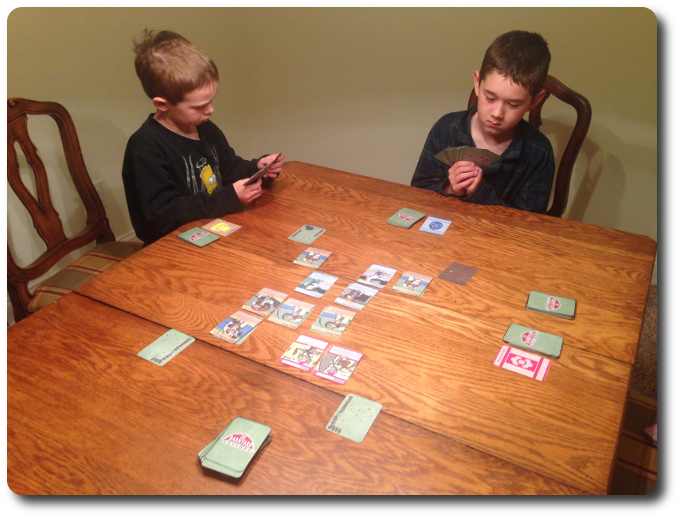
My two field commanders continually review their cards, frowning in concentration
The Parent Geeks, especially the casual gamers, found Barnyard Legions to be just the right mix of combative warfare and hand management. According to one Parent Geek, “I really like how all the cards are unique. This makes each card I have a potential game changer, but it also makes the game more challenging. My biggest concern is simply finding the best way to use each card!” Another Parent Geek said, “I like the game’s concept, but find moving the cards a bit cumbersome at times. I would have preferred a game board to indicate the battle area or tiles that are easier to pick up. Other than that, no complaints.” The non-gamer Parent Geeks were not as enthusiastic about the game, but the Parent Geeks with Child Geeks who enjoyed playing Barnyard Legions were most pleased with the experience. When all the votes were in, the Parent Geeks approved Barnyard Legions.
The Gamer Geeks liked how the cards had different abilities, but a number of them found the game to be a bit wonky. According to one Gamer Geek, “The list of actions I can take seems a bit long, almost as if the game designers wanted the card game to be everything to everyone. The only thing I apparently cannot do with my cards is use them for time travel.” Another Gamer Geek said, “There are some great combos here. I wish the rules did a better job of clarifying some of them, but I’m pleased with it in general.” The Gamer Geeks were divided when it came to the game’s ultimate goal. One Gamer Geek who didn’t care for the victory condition said, “Oh, so this entire time the game has been a card version of Connect Four? That seems silly.” Another displeased Gamer Geek said, “I would have preferred it if victory was obtained through control over key locations in the Barnyard, rather than getting my cows all in a single row.” But the victory conditions were not disliked by everyone and a number of Gamer Geeks thought the game worked just fine the way it was. According to one such Gamer Geek, “This is card game mimicking tactical positioning on the battleground. It does a great job of doing just that.” When all the votes were in, the Gamer Geeks gave Barnyard Legions a mixed level approval.
Barnyard Legions is a game that plays surprisingly fast, but will test your patience. Cards are easily removed and there are a number of ways to easily foil plans. All good stuff when you benefit, but annoying when you don’t. It can seem really easy at times to have cards removed and near impossible to get one to budge. It all comes down to what cards you have and how you spend your actions.
This is also a game that tends to let one player get an advantage and keep it. Random cards from the Common draw deck can sometimes keep giving 1 player exactly what they need. However, you can only put out so many cards per turn and only if there is room. Still, if the player is able to maintain their dominance and control the Barnyard area, there really isn’t anything an opponent can do to stop them. They can certainly attempt to slow them down, but that’s about it. Once a player gets momentum, they can use it to roll over other players. Luckily, the game is so easy to set up and play in such a short amount of time, even the most devastating of defeats can be quickly put aside as a new game begins.
Barnyard Legions is a great example of how cards can be used to play out big battles with very little table space. I found it had a good mix of the abstract and concrete, allowing for some very interesting tactical and strategic decision making. I believe this is not a game for everyone. It’s strangely heavy at times and can frustrate you, but it can then exhilarate the player and seem very breezy on the next turn. It strangely changes its face and the player must change their own point-of-view as often as they draw cards. It makes for an interesting gaming experience and one that I found to be satisfying. If you are looking for a card game that challenges your ability to plan ahead, react to new conditions, and subtly move into a position of power, then do try Barnyard Legions.
This is a paid for review of the game’s final prototype. Although our time and focus was financially compensated, our words are our own. We’d need at least 10 million dollars before we started saying what other people wanted. Such is the statuesque and legendary integrity of Father Geek which cannot be bought except by those who own their own private islands and small countries.



